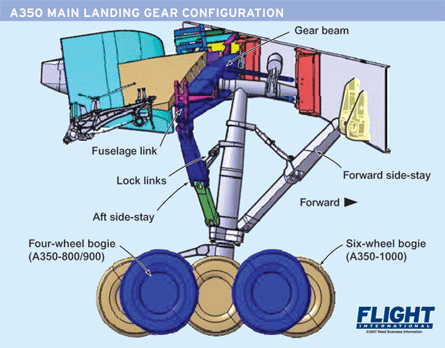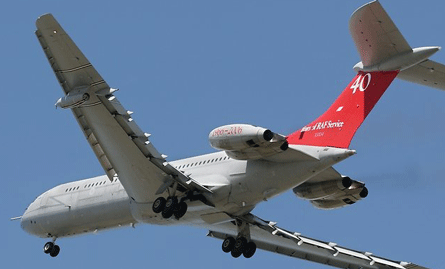Airbus has adopted a completely new philosophy for the attachment of the A350 XWB’s main landing gear as part of the switch to a composite wing structure. The solution it has developed borrows from the design of the Vickers VC10 of the 1960s.
Airbus has traditionally bolted the main landing gear to the rear spar of the wing. Airbus A350 XWB chief engineer Gordon McConnell says that if such a method were used with a carbonfibre wing there would be issues with the local thicknesses of the wingskins to take the load of the landing gear.
Each A350 main landing gear leg is attached to the rear wing spar forward and to a gear beam aft, which itself is attached to the wing and the fuselage. To help reduce the loads further into the wing, a double side-stay configuration was adopted. “Both these solutions have been used before on aircraft like the VC10,” says McConnell.

With the take-off weight range for the A350 family spanning 245t to 295t, Airbus has devised a three-pronged main landing
gear design philosophy encompassing both four- and six-wheel bogies to ensure it can keep the pavement loading within limits. “We want the A350’s aircraft classification number for a flexible runway below 75,” says McConnell.
 |
|---|
Airbus has adopted a VC10-style gear design (above) for the A350 XWB. Credit: AirTeamImages |
The A350-800 and -900 will both have four-wheel bogies, although the -800’s will be slightly shorter to save weight. Both will fit in the same 4.1m (13.5ft) long bay. “For the -1000, which has a 30t increase in take-off weight, we’ll go to a six-wheel bogey and a 4.7m landing gear bay – an increase of one bay frame,”says McConnell. There is provision to incorporate the six-wheel bogie and bay in future weight growth versions of the A350-900, such as the -900R extended range and -900F freighter, to ensure they retain the required pavement loadings.
Messier-Dowty was chosen for the original A350’s main landing gear, but Airbus has not revealed its selection for the XWB. Airbus says that a decision is expected “soon”, and although it is competing the nose gear separately, may opt for a packaged solution.
Source: Flight International


























